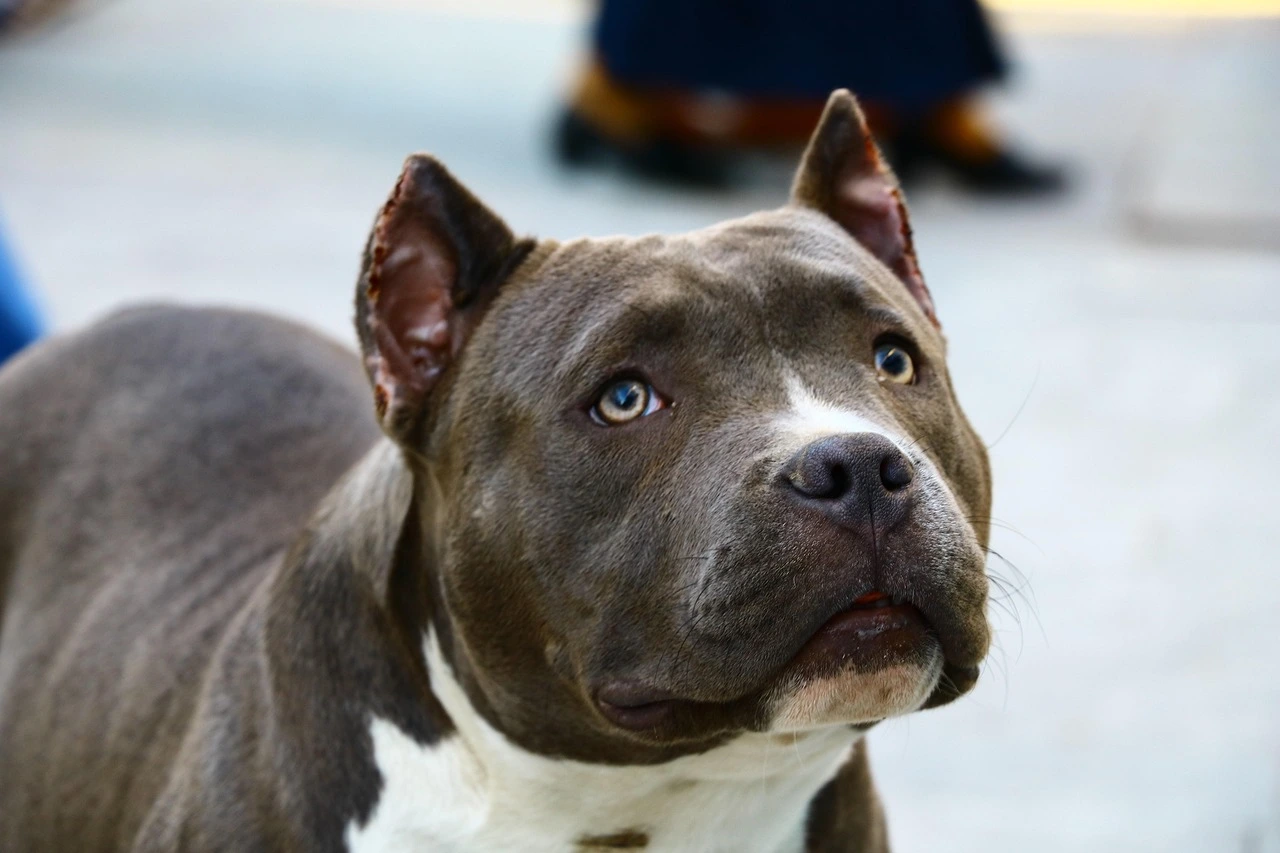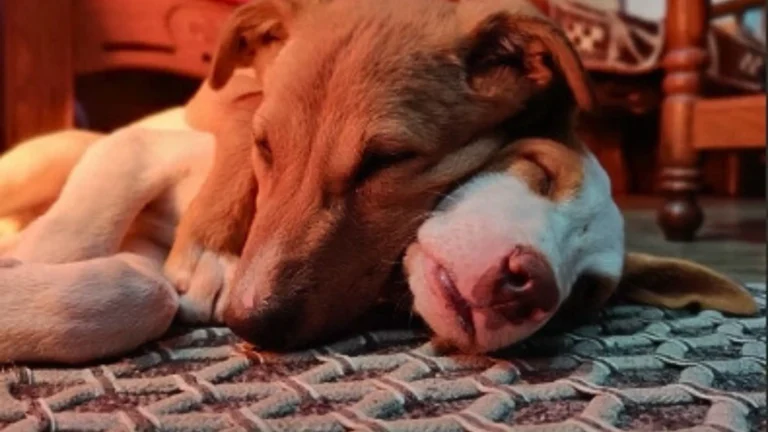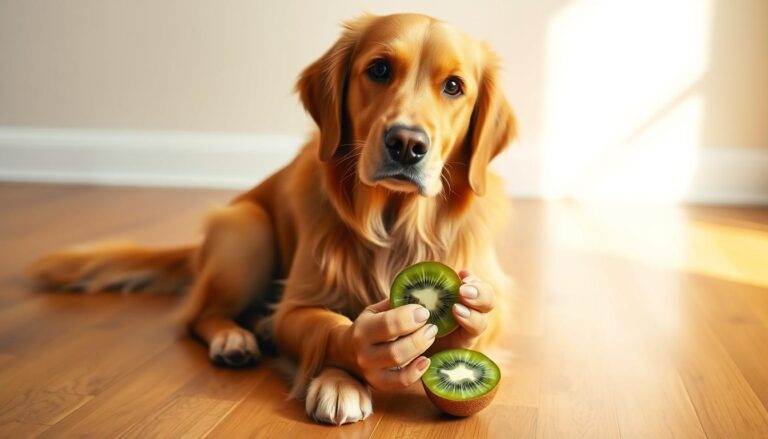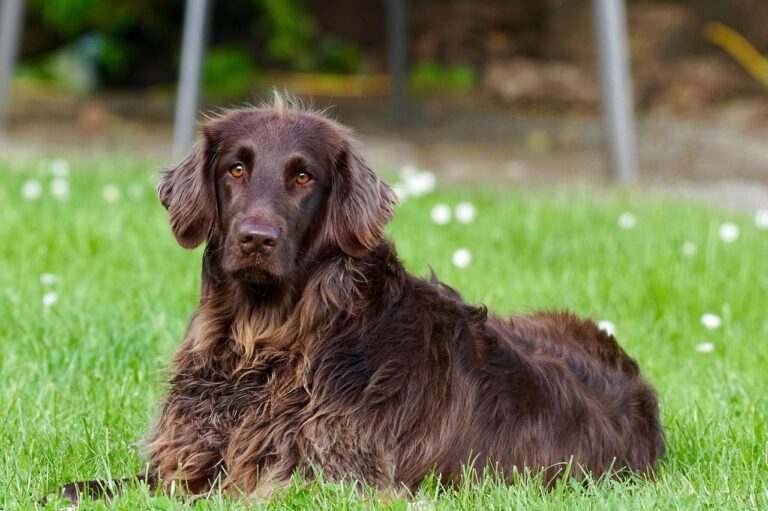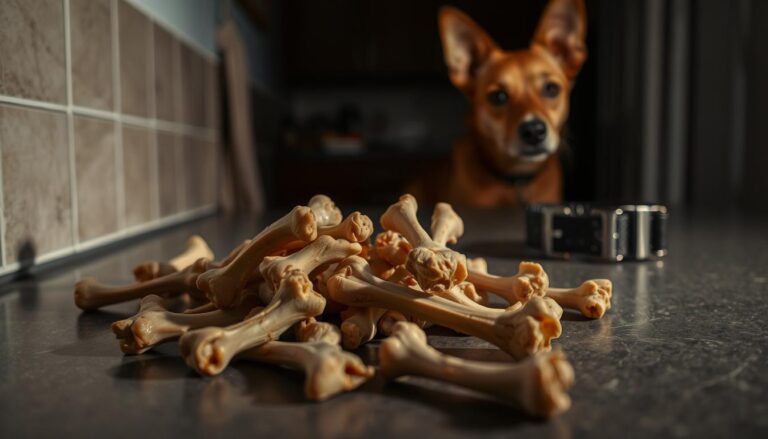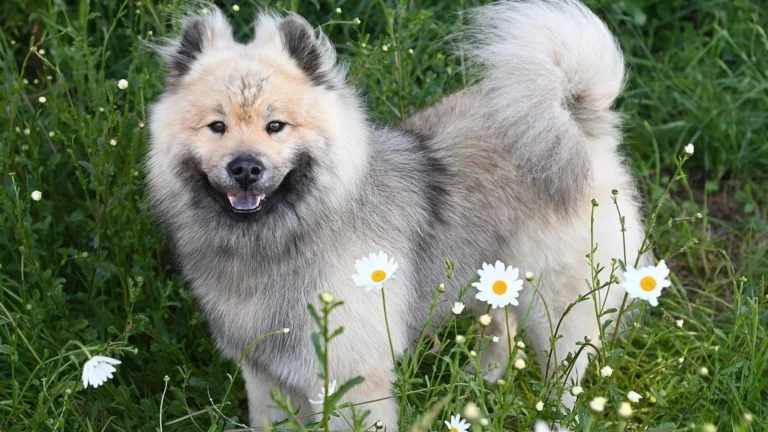Scariest Dog Breeds: The Most Fearsome Pups Revealed 101
When I first saw a huge Rottweiler at my neighbor’s gate, my heart skipped a beat. The intimidating dog stood guard, muscles flexing, eyes fixed. It sparked my curiosity about the scariest dog breeds.
Dogs have been with humans for thousands of years. But not all dogs are the same. Some are known for their size, history, and looks that make them seem scary.
What makes a dog seem scary can vary from person to person. Size, strength, protective nature, and history all play a part. Some dogs get a bad rap from movies or TV. Others are naturally protective.
This journey will explore the world of dogs that inspire both wonder and fear. We’ll look beyond their looks to understand what makes them seem so intimidating. It’s a deep dive into the fascinating world of dogs.
Table of Contents
Understanding What Makes a Dog Intimidating
Dogs can scare people with certain traits that make them seem scary. Knowing what makes dogs seem menacing helps clear up myths about aggressive breeds. It also gives us a better look at how dogs behave.
Fearful dogs aren’t just naturally dangerous. Many things contribute to how intimidating a dog seems:
Physical Characteristics That Create Fear
How a dog looks is key in how we see them. Traits that make dogs seem scary include:
- Large muscular body structure
- Broad chest and powerful shoulders
- Intense facial expressions
- Pronounced jaw muscles
- Dark or piercing eye color
The Role of Genetics and Breeding History
Genetics play a big part in a dog’s personality. Some breeds were made for protection or hunting. This means some aggressive breeds have traits that make them seem more scary.
“A dog’s behavior is a complex interaction between genetics, environment, and training” – Professional Dog Behaviorist
Environmental Factors and Training Impact
Genetics are important, but where a dog grows up matters too. Good socialization, positive training, and consistent care can change a scary dog into a friendly one.
- Early socialization reduces fear responses
- Positive reinforcement builds trust
- Consistent training establishes clear boundaries
Knowing these points helps us see that a dog’s scary look doesn’t mean they’re always dangerous.
The Most Powerful Bite Forces in the Canine World
Exploring dangerous dog types, we find bite force is key. It shows how strong a dog’s jaw is. This tells us about their power and potential dangers.
The Kangal is a chilling dog with a jaw that can exert 743 pounds per square inch (PSI). This Turkish breed was made to protect livestock. It has the strongest jaw in dogs.
Let’s look at the strongest bite forces in different breeds:
- Kangal: 743 PSI – The undisputed champion of bite strength
- Cane Corso: 700 PSI – An Italian breed known for muscular build
- American Bandogge: 730 PSI – A powerful mixed-breed dog
- Rottweiler: 328 PSI – A well-known guardian breed
Bite force doesn’t automatically mean a dog is aggressive. These dogs are strong, but how they act depends on their training and personality.
Vets say owning a dog responsibly and training it well is more important than its strength. Knowing a breed’s traits helps owners choose the right dog for them.
Guardian Breeds With Fearsome Reputations
Some dog breeds are top-notch guardians. They are known for being the scariest dogs in the world. They have strength, smarts, and loyalty.
Guardian breeds are a key defense in security. Their strength and protective nature make them great for many roles.
Traditional Protection Dogs
Many dog breeds were made for protection. They have special traits that make them great guardians:
- German Shepherds: Known for incredible intelligence and versatility
- Doberman Pinschers: Sleek, athletic, and highly trainable
- Rottweilers: Powerful and naturally protective
Modern Security Applications
Today, guardian breeds are used in many security roles. They work in:
- Personal protection
- Law enforcement
- Military operations
- Property security
| Breed | Primary Security Role | Key Characteristics |
|---|---|---|
| German Shepherd | Police/Military Work | High intelligence, quick learning |
| Doberman Pinscher | Personal Protection | Aggressive stance, loyal nature |
| Rottweiler | Property Guardian | Muscular build, territorial instinct |
Training Requirements for Guard Dogs
To make these breeds good guardians, they need extensive professional training. They need socialization, obedience, and exposure to different places. This helps them become balanced and effective.
Trainers say these dogs are not naturally dangerous. They just need the right training and socialization. It’s all about understanding their traits and guiding them well.
Scariest Dog Breeds in Popular Culture
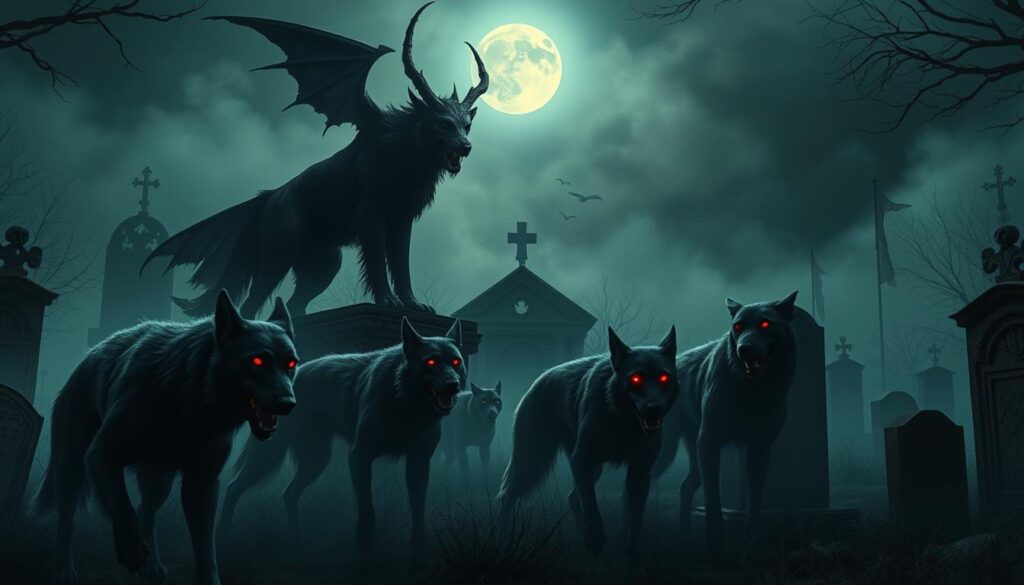
Popular culture has made some dog breeds seem spooky. They’ve become iconic frightening pets that grab our attention. From old horror movies to today’s shows, certain breeds keep showing up as scary characters. This has shaped how people see them.
Some of the most memorable spooky dogs in movies are:
- Doberman Pinschers as ruthless guard dogs in action movies
- Rottweilers portrayed as aggressive attack animals
- Pit Bulls depicted as dangerous street fighters
Hollywood often makes these breeds seem more menacing than they are. Movies like The Omen and Cujo have made dogs seem like threats. This has made people see them as scary rather than loving friends.
But, animal experts say there’s more to dog breeds than what movies show. They point out that a dog’s behavior is more about how it’s raised than its breed. Media often ignores how a dog’s upbringing affects its behavior.
“A dog’s behavior is more about upbringing than breed” – Professional Dog Trainer
Knowing about these cultural views helps us see movies about spooky dogs in a new light. It shows us the difference between what movies say and how dogs really are.
Giant Breeds That Command Respect
Giant breeds are among the most intimidating dogs. They stand out with their massive size and powerful presence. These dogs are both towering guardians and gentle giants, showing the highest level of canine size and strength.
Size and Strength Considerations
Giant dog breeds are truly awe-inspiring. The Great Dane, for example, can grow over 30 inches tall and weigh up to 180 pounds. They are not just big; they are incredibly strong and muscular.
- Great Dane: Up to 34 inches tall
- English Mastiff: Can weigh up to 230 pounds
- Newfoundland: Known for massive build and strength
Special Care Requirements
Having a giant breed requires special care and knowledge. These dogs need:
- Extra-large living spaces
- High-calorie nutritional plans
- Specialized veterinary care
- Extensive exercise routines
Common Misconceptions About Large Dogs
“Size doesn’t determine temperament. Many giant breeds are gentle giants.”
Many believe large dogs are always aggressive. But, with the right training and socialization, they can become loving family pets. Their size hides their gentle and patient nature.
| Breed | Average Height | Temperament |
|---|---|---|
| Great Dane | 28-34 inches | Gentle, Friendly |
| English Mastiff | 27-30 inches | Calm, Protective |
| Newfoundland | 26-28 inches | Patient, Sweet-natured |
Understanding these dogs goes beyond their size. With the right care, training, and respect, giant breeds can be amazing companions. They challenge our views of the scariest dogs.
Fighting Dog Heritage and Modern Temperament
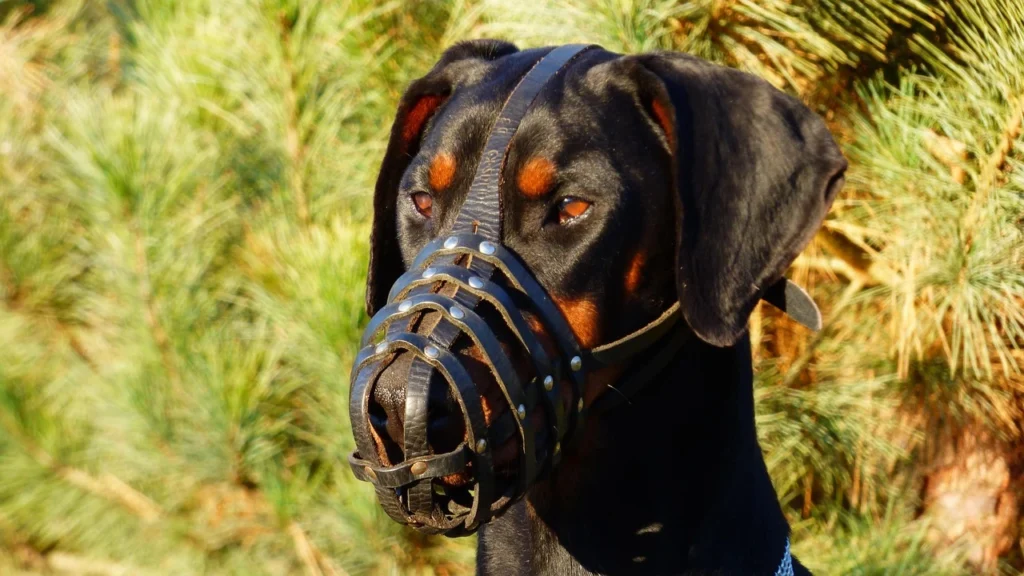
The world of aggressive dog breeds has a complex history. Breeds like the American Pit Bull Terrier and Staffordshire Bull Terrier have a deep connection to blood sports and fighting. This history is more than just simple stereotypes.
These breeds were bred for specific traits that made them good fighters. Their genes show centuries of breeding for strength and determination.
“A dog’s past does not dictate its future” – Professional Dog Trainer
Today, we see these breeds in a different light:
- Genetic predispositions don’t mean a dog will always be aggressive
- Good training can turn potentially dangerous dogs into loving pets
- Environment and socialization are key in shaping a dog’s personality
When dealing with breeds from a fighting background, being a responsible owner is crucial. Knowing their history helps build positive bonds between these dogs and their families.
Experts say early socialization, consistent training, and a loving home can change a dog’s nature. This is true for breeds with a history of aggression.
Working Dogs With Intimidating Presence
The world of professional working dogs is at the top of canine skills. These dogs are not just pets but are trained to serve in military, police, and security roles. They are the scariest dogs you’ll find, but they are also highly trained professionals.
Professional working dogs show the strongest traits of the scariest dog breeds. They are chosen for their physical and mental skills. These skills help them excel in stressful situations.
Military and Police Service Canines
Elite working dogs are trained to be crucial partners in tough missions. The most famous breeds include:
- Belgian Malinois
- German Shepherd
- Dutch Shepherd
- Doberman Pinscher
Professional Training Protocols
Training these dogs needs special methods. These methods enhance their natural talents while keeping control. Important training areas include:
- Intensive obedience training
- Scent detection techniques
- Aggression management
- Situational response conditioning
Handler Requirements and Qualifications
Handlers of these dogs must have top-notch skills:
| Qualification | Required Skills |
|---|---|
| Physical Fitness | Advanced strength and endurance |
| Psychological Stability | Calm under extreme pressure |
| Technical Training | Advanced canine behavior understanding |
These working dogs are a perfect mix of natural intimidation and professional training. They turn potentially dangerous traits into valuable service skills.
Ancient Guardian Breeds
Ancient guardian breeds are truly remarkable protectors with deep roots. They developed skills to guard livestock, property, and families in tough environments. They come from different continents.
The scariest dog breeds come from places needing strong protection. Their history shows centuries of breeding for strength, smarts, and a strong sense of territory.
- Tibetan Mastiffs: Legendary mountain guardians
- Caucasian Shepherds: Powerful Russian working dogs
- Fila Brasileiro: Brazilian tracking and protection specialists
These ancient breeds have key traits that make them great guardians:
| Breed | Origin | Primary Protection Role |
|---|---|---|
| Tibetan Mastiff | Himalayan Regions | Livestock Protection |
| Caucasian Shepherd | Russian Mountains | Territory Defense |
| Fila Brasileiro | Brazilian Farms | Property Guarding |
To understand these breeds, we must see their complex nature. They are not just dogs, but living historical artifacts with remarkable protective capabilities. Their independent thinking and strong territorial instincts make them challenging yet fascinating companions for experienced dog owners.
Ancient guardian breeds represent thousands of years of human-canine partnership in protection and survival.
Breeds Often Misunderstood as Aggressive
Dog breed stereotypes are often wrong. Many aggressive dog breeds are judged unfairly because of how they look or past myths. Knowing how dogs behave helps us fight these myths.
Fear-inducing canines get a bad rap because of a lack of knowledge about them. Breeds like Rottweilers, Doberman Pinschers, and Chow Chows are often seen as scary. But they can be loving pets.
Common Behavioral Misconceptions
There are a few big myths about dog breeds:
- Large dogs are automatically more dangerous
- Protective behaviors indicate inherent aggression
- Breed determines a dog’s entire personality
Understanding Breed-Specific Traits
Every dog breed has its own traits that might seem aggressive. Genetic predispositions don’t mean a dog will be violent. Training, socialization, and temperament also matter a lot.
“A dog’s behavior is more about nurture than nature.” – Professional Dog Trainer
Breaking Down Stereotypes
Good ownership can change how we see aggressive dog breeds. Training, positive feedback, and knowing each dog’s personality can make a big difference.
Learning about different breeds helps fight harmful stereotypes. It leads to a kinder view of our furry friends.
Legal Considerations for Dangerous Breeds
Understanding the laws about dangerous dog types can be tough for those who want to own a dog. Each area has its own rules about scary dog breeds. These rules can really affect your ability to have certain dogs.
“Understanding local laws is crucial before bringing a potentially dangerous breed into your home.” – Animal Legal Defense Fund
Breed-specific laws (BSL) change a lot in the United States. Some important things to know include:
- Mandatory muzzling in public spaces
- Higher insurance requirements
- Specific licensing restrictions
- Potential breed ownership bans
Local places have different ways to handle dangerous dog types. As an owner, you might need to do simple things like register your dog. Or, you might have to follow more complex rules.
| Breed Classification | Common Legal Restrictions | Insurance Requirements |
|---|---|---|
| Pit Bull | Banned in some cities | $500,000 liability coverage |
| Rottweiler | Restricted in certain areas | $300,000 liability coverage |
| German Shepherd | Limited public space access | $250,000 liability coverage |
Before getting one of these scary dog breeds, check your local laws well. Talk to local animal control and learn about breed-specific rules. This can help you make a smart choice and avoid legal problems.
Conclusion
Exploring the scariest dog breeds shows each dog is unique. These dogs aren’t naturally dangerous. They need owners who understand their needs.
Good ownership means looking beyond stereotypes. It’s about understanding each breed’s traits. Whether it’s a big guardian dog or a large working dog, research is crucial.
Consistent training, early socialization, and meeting their needs are key. Professional trainers and vets say breed reputation doesn’t define a dog’s behavior. With patience, structure, and compassion, even the scariest dogs can become loving family pets.
Choosing a dog breed should be a thoughtful decision. Consider your lifestyle, living situation, and care abilities. With knowledge, respect, and dedication, you can form a strong bond with any dog, no matter how intimidating.

